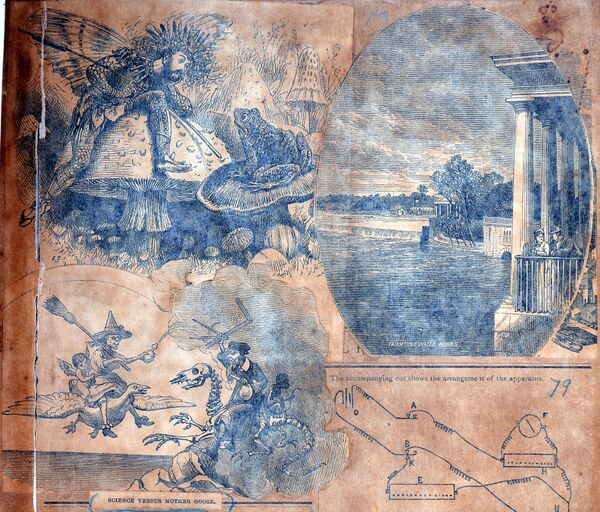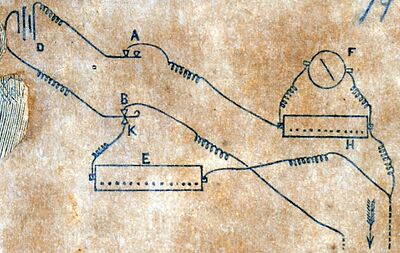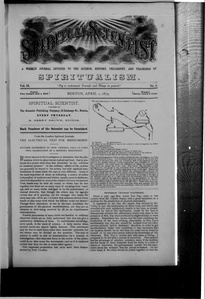
Science Versus Mother Goose
The Electrical Test for Mediumship
By what means is the investigator to determine that the phenomena which he observes are indeed spiritual: that is produced by a power other than that furnished by the volitions of someone present? In the ordinary affairs of life, actions can generally be traced to the actors, but with spiritual manifestations of some kinds the case is very different. Some of the most important of these, as indicating a source of action independent of mediums and sitters, usually occur in darkness, when it is impossible to control the conduct of every one present True, hands may be held all round, or wrists may be tied together, but there are so many ways of escaping from bondage, and so many tricks indulged in by the practitioners of manual dexterity, that though the sitters may be morally certain that all is genuine, yet the stranger who hears the story may ask—How am I to know that someone did not loose hands or play some trick which his fellows could not detect ? Though these objections do not in the least invalidate the genuineness of the physical manifestations, yet they are an obstacle to their being received by all as an experimental demonstration.
Natural phenomena of many kinds are familiar to ordinary observers which are so little understood that few can give a satisfactory definition of them. To individualise knowledge, so to speak, is the work of science. A table moves when several hands are placed lightly thereon. This movement may be due to some force other than muscular pressure, but the sitters may be divided on the question. The man of science is called in, and he demonstrates—by a process of investigation—that muscular force or the action of the sitters could in no wise cause the movements; and so it is rendered certain that they are due to some other agency.
This important proposition has once more been demonstrated by Prof. Crookes.
The accompanying cut shows the arrangement of the apparatus.

D, battery. F, galvanometer
H, shunt to cut off more or less of the current in order to regulate the defection of the galvanometer.
E, box of romance coils.
A and B, keys to make and break contact.
(A) it always dated, and used only to correct or check zero.
(B) pressed down to K, puts the resistance coils in place of the medium.
The two wires on each side of the arrow go to the medium.
The electrical apparatus will be readily understood from the diagram, by those skilled in electrical science. Our illustration gives the course of the current and connection of the parts, but does not convey an idea of the apparatus as it appears to the general observer; further explanation may, therefore, be useful to the uninitiated. On a shelf under the sideboard on which the apparatus was fixed stood the battery (D) of two cells. The “shunt" (H), externally a small mahogany box, was placed in the immediate front of the sideboard to the left. The “resistance-coils” (E) of similar appearance stood to the right. Behind the shunt was the galvanometer (F), and behind the resistance-coils a lantern, the light from which fell on the galvanometer, and was reflected from thence to a broad graduated scale, which was placed horizontally on its edge to the right of the resistance-coils, and at a right angle with the sideboard, and so constituted the extreme right of the apparatus opposite to the galvanometer on the left. Two wires passed from the apparatus through the side of the doorway to the corner of the library behind the wall, where sat Mrs. Fay. These wires were supplied with handles of the ordinary kind, and when these were grasped with the wetted hands, the electrical circuit was established; when the handles were liberated the current was broken.
<Untitled> (I've told you a story, of Jack in his glory)
(*)"I've told you a story, of Jack in his glory, |
Professor Crookes Statement
About a year ago Mrs. Annie Eva Fay, came to this country from the United States, with a good reputation as a medium for the production of physical phenomena.
It appeared to me that the means first devised by Mr. Varley to test the mediumship of Miss Cook, and which was attended with such satisfactory results in her case, as already recorded by him in The Spiritualist, would be the best to demonstrate whether the phenomena which took place in the presence of Mrs. Kay were produced by slight-of-hand or were genuine. Experience has shown that the best conditions for production of the most striking phenomena in Mrs. Fay’s mediumship are, that she should be isolated from the other persons present, and in darkness; therefore, in order to get manifestations under test conditions, it was necessary that the medium should be so tied that she could not be freed by herself or by any other power without the knowledge of the observers. Mrs. Fay is usually tied with tapes or string; I proposed to tie her with a current of electricity. This method has the advantage of absolute certainty, since. If the medium has her hands or body removed from the wires, in a state of trance or otherwise, the galvanometer outside lets the spectators know the moment that the circuit it broken. On the other hand, if the wires should be joined together so that the <... continues on page 3-160 >
Editor's notes
- ↑ Science Versus Mother Goose by unknown author. collage
- ↑ The Electrical Test for Mediumship by unknown author, Spiritual Scientist, v. 2, No. 4, April 1, 1875, p. 37
- ↑ Fairmount Water Works by unknown author
- ↑ I've told you a story, of Jack in his glory by unknown author
- ↑ Professor Crookes Statement by unknown author, Spiritual Scientist, v. 2, No. 4, April 1, 1875, p. 37
Sources
-
Spiritual Scientist, v. 2, No. 4, April 1, 1875, p. 37

